This topic contains basic procedures to follow when network rendering with 3ds Max.
The following conditions are assumed:
- 3ds Max has been installed on all machines to use as rendering servers. Note: You needn't license 3ds Max on machines to be used only as rendering servers.
- All network communications and protocols are installed and operating correctly.
- Each computer runs a recent version of Windows, such as Windows 7. Limitations of other operating systems could cause network rendering to be unreliable.
- All of the computers have names that start with letters. Machine names that start with a number will fail.
- You haven't attempted network rendering previously. If you have already attempted network rendering and want to return to the original state, delete everything in the \Program Files\Autodesk\Backburner\Network folder except nrres.dat.
- Manager and Server have not been installed as services.
In This Topic
Summary of Procedures
- Procedure 1 - Use this procedure for configuring a single system to render jobs to itself; in other words, to perform batch rendering that is managed by Backburner.
- Procedure 2 - Use this procedure for configuring a Backburner Manager system to render to one or more Backburner Server systems. The Manager system will not be involved in the rendering tasks.
- Procedure 3 - Use this procedure for configuring the Backburner Manager and Backburner Server systems to render tasks together.
Special Consideration for Procedures 2 and 3
To use a render farm, you must output a frame sequence in a still-image file format; for example, a series of BMP files. You cannot render animated file formats such as AVI or MOV to multiple systems. You must render animated files to a single system. When rendering to an animated file format, the Use All Servers checkbox in the Network Job Assignment dialog is unavailable.
Basic Procedure 1: Single-System Network Rendering
This procedure describes usage of network rendering on a single computer. The main advantage to this method over standard rendering is that you can submit multiple rendering jobs for the computer to render. In effect, this lets you perform batch rendering.
- Go to Start menu
 Programs
Programs  Autodesk
Autodesk  Backburner and choose the
Backburner and choose the  Manager menu item.
Manager menu item. This starts Manager and creates the backburner.xml file in the Backburner\Network folder.
When you run Manager for the first time, you will see the Backburner Manager General Properties dialog, shown below.
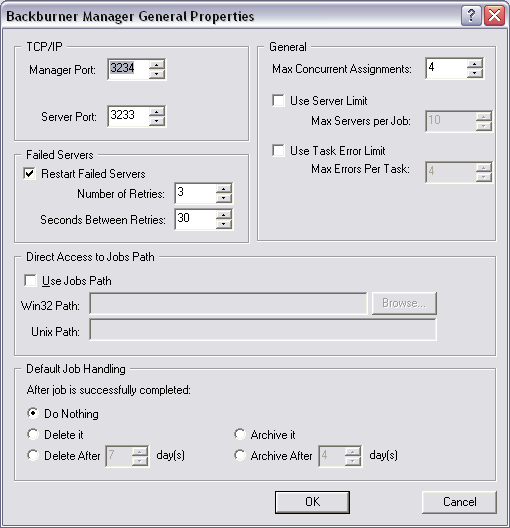
Backburner Manager General Properties dialog.
- Click OK to accept the default settings.
The Backburner Manager dialog displays.
- Go to Start menu
 Programs
Programs  Autodesk
Autodesk  Backburner and choose the
Backburner and choose the  Server menu item.
Server menu item. This starts Server and creates the server data that is stored in the backburner.xml file.
You will see the Backburner Server General Properties dialog, shown below, when you run Server for the first time.
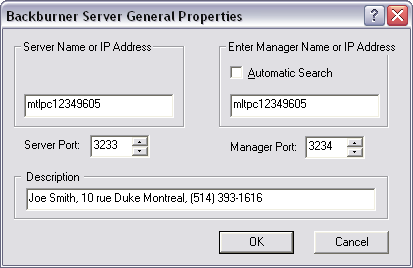
Backburner Server General Properties dialog.
- Click OK to accept the default settings.
The Backburner Server dialog displays. After a few moments, messages appear in both the Server and Manager windows indicating that the Server has successfully registered with the Manager.
- Start 3ds Max and load the first scene you want to render.
- From the Rendering menu, choose Render Setup, or on the main toolbar, click
 (Render Setup).
(Render Setup). - Set the rendering parameters and specify an output file name. From the Render button drop-down menu, choose Submit To Network Rendering.

3ds Max opens the Network Job Assignment dialog.
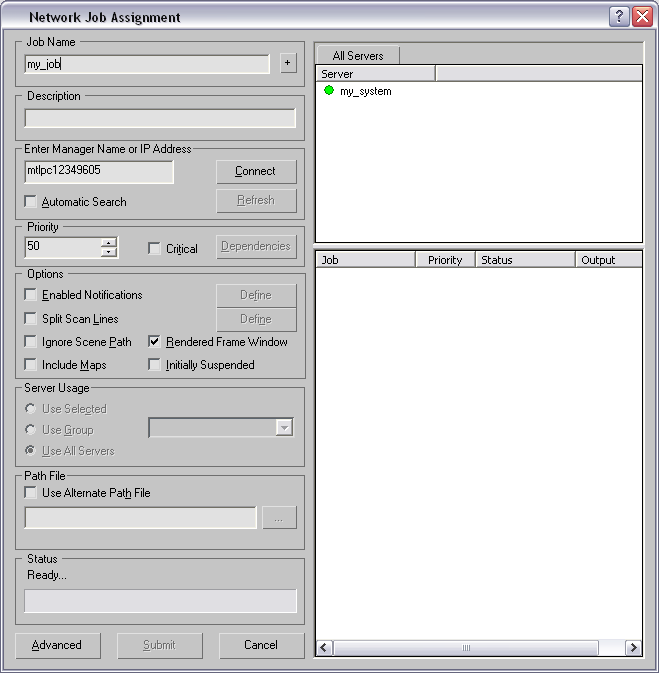
Network Job Assignment dialog showing the server station that is also running Manager.
- Enter a job name (it's a good idea to change the default name) and then click the Connect button.
The name of your computer (that is, the Server) appears in the Server window to the right. It has a green dot next to it meaning that it is a Server system that is ready to start rendering.
- Click the Server name to highlight it in the list window, and then click the Submit button.
The Manager submits the job to the Server, both running only on this system, and the Server begins rendering each still frame or the animation.
- To render additional jobs, load each into 3ds Max, and then repeat steps 6 to 9.
You can submit as many jobs as you like. The Manager will queue the jobs up and render them in the order that you submitted them.
Basic Procedure 2: Network Rendering from Server (not Manager)
When rendering across a network, you first assign one machine to be Manager, and then any number of others as Servers. In this procedure, you won't use the Manager as a rendering Server.
- Go to Start menu
 Programs
Programs  Autodesk
Autodesk  Backburner and choose the
Backburner and choose the  Manager menu item.
Manager menu item. This starts Manager and creates the backburner.xml file in the Backburner\Network folder.
When you run Manager for the first time, you will see the Backburner Manager General Properties dialog, shown below; this is normal.

Backburner Manager General Properties dialog.
- Click OK to accept the default settings.
The Backburner Manager dialog displays.
- Move to a Server system.
- Go to Start menu
 Programs
Programs  Autodesk
Autodesk  Backburner and choose the
Backburner and choose the  Server menu item.
Server menu item. This starts Server and creates the server data that is stored in the backburner.xml file.
You will see the Backburner Server General Properties dialog box, shown below, when you run Server for the first time.

Backburner Server General Properties dialog.
- Click OK to accept the default settings.
The Backburner Server dialog displays. After a few moments, messages appear in both the Server and Manager windows indicating that the Server has successfully registered with the Manager.
- Repeat steps 3-5 on all the Server systems you intend to make available for your rendering jobs.
- Return to the Manager system, start 3ds Max, and load the first scene you want to render.
- From the Rendering menu, choose Render Setup, or on the main toolbar, click
 (Render Setup).
(Render Setup). - Set the rendering parameters and specify an output path and file name. Tip: So that the Servers can find the output path, specify the path in the Render Output File dialog starting with Save In
 My Network Places. Then navigate to the output folder, specify a file name and output format (Save As Type), and click Save.
My Network Places. Then navigate to the output folder, specify a file name and output format (Save As Type), and click Save. - From the Render button drop-down menu, choose Submit To Network Rendering.

The Network Job Assignment dialog appears.
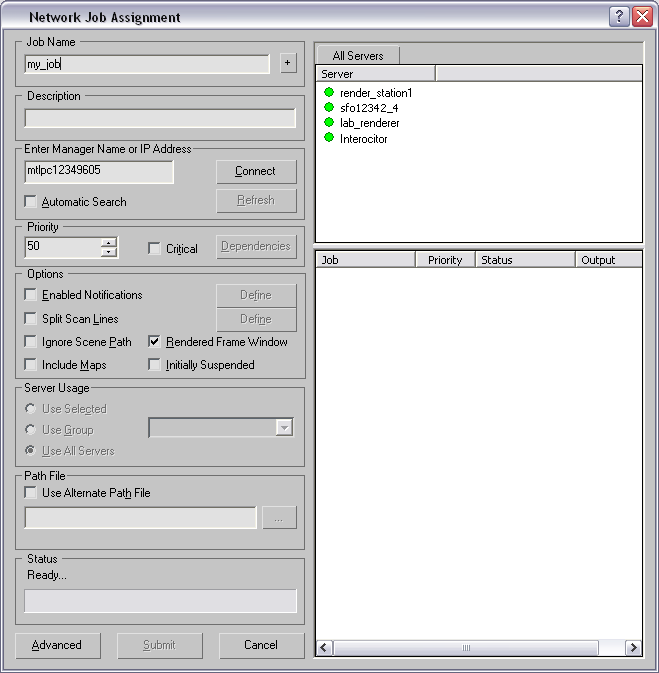
Network Job Assignment dialog showing all the server stations. The manager station is excluded.
- Enter a job name (it's a good idea to change the default name) and then click the Connect button.
The names of all Servers appear in the Server window to the right. Those with green dots next to their names are ready to start rendering.
By default, all the Servers that are listed will take part in the rendering job. To assign a specific Server to render a job, first turn off Use All Servers in the Options group, and then highlight the server(s) that you want to render the job.
- Click the Submit button.
The Manager submits the job to the Servers, which begin rendering .
At this point, you can load and submit additional scenes. When the first job is complete, the next job will automatically begin rendering on the Servers.
Basic Procedure 3: Network Rendering from Manager and Servers
When rendering across a network, you first assign one machine to be Manager, and then any number of others as Servers. In this procedure, you'll use the Manager computer as a rendering Server as well.
- Go to Start menu
 Programs
Programs  Autodesk
Autodesk  Backburner and choose the
Backburner and choose the  Manager menu item.
Manager menu item. This starts Manager and creates the backburner.xml file in the Backburner\Network folder.
When you run Manager for the first time, you will see the Backburner Manager General Properties dialog, shown below; this is normal.

Backburner Manager General Properties dialog.
- Click OK to accept the default settings.
The Backburner Manager dialog displays.
- On the same computer, go to Start menu
 Programs
Programs  Autodesk
Autodesk  Backburner and choose the
Backburner and choose the  Server menu item.
Server menu item. This starts Server and creates the server data that is stored in the backburner.xml file.
You will see the Backburner Server General Properties dialog box, shown below, when you run Server for the first time.

Backburner Server General Properties dialog.
- Click OK to accept the default settings.
The Backburner Server dialog displays. After a few moments, messages appear in both the Server and Manager windows indicating that the Server has successfully registered with the Manager.
- Repeat steps 3 to 4 on all the Server systems you intend to make available for your rendering jobs.
- Return to the Manager system, start 3ds Max, and load the first scene you want to render.
- From the Rendering menu, choose Render Setup, or on the main toolbar, click
 (Render Setup).
(Render Setup). - Set the rendering parameters and specify an output path and file name. Tip: So that the Servers can find the output path, specify the path in the Render Output File dialog starting with Save In
 My Network Places. Then navigate to the output folder, specify a file name and output format (Save As Type), and click Save.
My Network Places. Then navigate to the output folder, specify a file name and output format (Save As Type), and click Save. - From the Render button drop-down menu, choose Submit To Network Rendering.

The Network Job Assignment dialog appears.
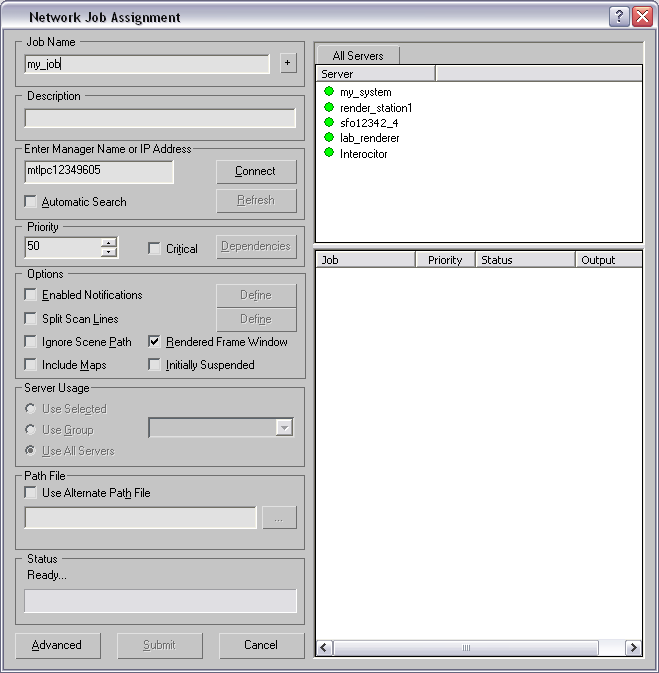
Network Job Assignment dialog showing all the server station plus the manager station that is running Server.
- Enter a job name (it's a good idea to change the default name) and then click the Connect button.
The names of all Servers appear in the Server window to the right. Those with green dots next to their names are ready to start rendering.
By default, all the Servers that are listed will take part in the rendering job. To assign a specific Server to render a job, first turn off Use All Servers in the Options group, and then highlight the server that you want to render the job.
- Click the Submit button.
The Manager submits the job to the Servers, which begin rendering .
At this point, you can load and submit additional scenes. When the first job is complete, the next job will automatically begin rendering on the Servers.